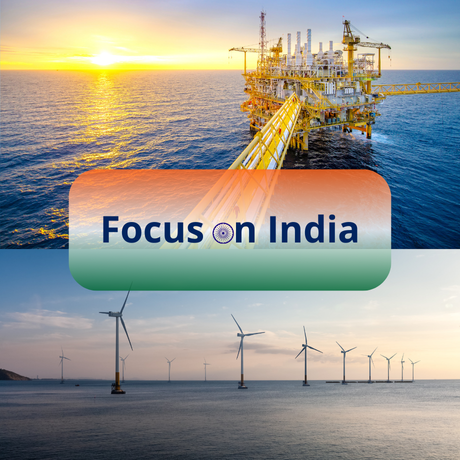
Focus on India
Introduction
India has a significant amount of coastline, stretching nearly 7600km, which makes the country a prime location for harnessing offshore energy potential; The Indian government are doing just that, investing in developing infrastructure for new oil and gas projects, which remain an important part of the country’s economy, as well as beginning to develop their offshore wind infrastructure, in line with their target of achieving net zero by 2070.
Also significant is their development of their overall energy infrastructure, onshore as well as offshore, as they are seizing the opportunities provided by new renewable energy technology. According to the International Energy Agency (IEA) last released World Energy Outlook focused on India in 2021 “India is set to lead the world in areas like solar power and batteries in the coming decades.”
Making Electricity Accessible for All
Demand for energy has been steep in India, largely related to its population size and density. The government has a plan to bring electricity to every village, which has been successfully brought forward to 2025. The country has already made huge strides in increasing access to electricity in recent years: in the last decade, India has been able to increase electricity users by almost 50 million people per year – around the population of Spain – which is quite a feat!
Oil and Gas
India currently imports around 85% of their oil, but has huge energy potential, which could signifyingly reduce that reliance on imports. To date, only approximately 10% of potentially oil-producing basins have been explored, and this is a major area of investment for the current government.
In 2022, Mr. Hardeep Singh Puri, Minister of Petroleum & Natural Gas, announced that India would double its exploration area of oil and gas to 0.5 million sq. km. by 2025 and to 1 million sq. km. by 2030, aiming to significantly increase domestic output.
This is also an attractive area of investment for several major energy companies such as Chevron, ExxonMobil and TotalEnergies, who have all shown an interest in the area. This year BP has also made a significant commitment to increase oil production by 44% and gas output by 89% from the from the Mumbai High field, India’s largest oil field, located off the west coast. These international investments will help make electricity affordable, accessible and reliable across the country.
Offshore Wind
Alongside oil and gas, renewable energy is also a booming sector in India and will help make electricity available to the whole population. Given the substantial coastline and good windspeeds, particularly to the south, offshore wind development is a great way of boosting energy capacity and, based on figures from the Ministry of New and Renewable Energy (MNRE) of India, the country’s offshore wind energy potential is estimated to be 70 GW. The regions with the most potential offshore wind power are Gujarat and Tamil Nadu.
This interest in wind is not new. For many years, the Facilitating Offshore Wind in India (FOWIND) project, collaborating with the European Union and Global Wind Energy Council (GWEC), aimed to help India harness this resource, and now these collaborative efforts are coming to fruition.
In a very recent report by GWEC, The APAC Supply Chain Report published in November 2024, India is highlighted as a key market for offshore wind in the Asia-Pacific region. Becoming a major player, the Indian government has a target of reaching 37 GW of offshore wind by as soon as 2030.
India’s first offshore wind farm, a demonstration project located off the coast of Gujarat, near Pipavav port, is currently in development– once complete it will have a capacity of 500MW. The tendering process is also underway to bring offshore wind development to Tamil Nadu, which has excellent links to existing infrastructure, shallow sea beds and high wind speeds.
Solar power is already an important source of renewable energy in India and, realising this potential coupled with offshore wind, is a key part of the country’s energy policy. Finance Minister Nirmala Sitharaman has recently increased the budget allocation for the renewable energy sector by 53% which will benefit developing solar and wind infrastructure.
UK-India Offshore Taskforce
UK Energy Minister Ed Miliband has brought together UK companies who are using their expertise to contribute to India’s energy transition. Amongst these is the Venterra Group, of which FoundOcean is a proud founding member. Our collective experience in the offshore wind sector globally positions us to make a positive impact on India’s offshore energy industry and take hold of this moment of opportunity.
The formation of a joint UK-India Offshore Wind Taskforce, announced in February this year, will focus on “advancing offshore wind ecosystem development, supply chains, and financing models in both countries.” This is the fourth India-UK Energy Dialogue, aimed at “advancing mutual energy transition goals, ensuring energy access, and building secure and sustainable clean energy supply chains while aligning these efforts with economic growth.” For more detail, check out the gov.uk website.
Conclusion
India stands at a pivotal point in its energy journey, where making the most of both traditional resources and renewable innovation is shaping an accessible and reliable energy landscape. With government backing and international partnerships, alongside a commitment to offshore development in both oil and gas and wind, India is a really exciting place to watch for the energy sector – set to become a major player in the Asia-Pacific region.
With our wealth of experience in both the industry and the region, FoundOcean is really excited to play its part in the developing offshore energy sector in India.
For more information on FoundOcean’s experience and capabilities, contact the team on +44 1506 440330 or email info@foundocean.com